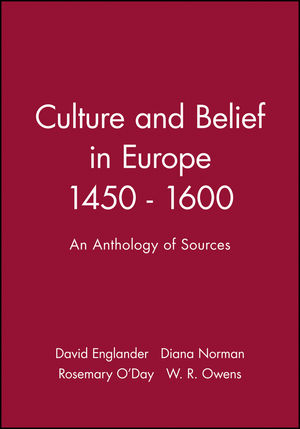Culture and Belief in Europe 1450 - 1600: An Anthology of SourcesISBN: 978-0-631-16991-8
Paperback
508 pages
January 1991, Wiley-Blackwell
 This is a Print-on-Demand title. It will be printed specifically to fill your order. Please allow an additional 10-15 days delivery time. The book is not returnable.
|
||||||
This open university reader is a wide-ranging interdisciplinary
collection of material from primary sources, illustrating the
relationship between cultural change and religious belief in
sixteenth-century Europe. It contains more than eighty extracts
drawn from a variety of genres including political, religious,
philosophical and legal writing, diaries, letters, plays, poems and
fiction. Some have never previously been published, others have not
been reprinted since their original appearance in the sixteenth
century, and a number are translated into modern English for the
first time.
`Culture and Belief in Europe 1450 - 1600' includes writing from such renowned thinkers as Erasmus, Luther, Machiavelli, and Sir Thomas More, besides that of lesser-known authors. Works of literature also feature extensively, and writings from Cervantes, Rabelais, Edmund Spenser, and Sir Philip Sidney amongst many others are all to be found here.
A general introduction describes the anthology's central aim - to explore aspects of the interrelationship between the politics, religion and writing of the period. The book is divided into eight thematic sections.
Spelling in the extracts has been sensitively modernized throughout, and the editors provide a headnote and appropriate explanatory annotation for each item.
`Culture and Belief in Europe 1450 - 1600' includes writing from such renowned thinkers as Erasmus, Luther, Machiavelli, and Sir Thomas More, besides that of lesser-known authors. Works of literature also feature extensively, and writings from Cervantes, Rabelais, Edmund Spenser, and Sir Philip Sidney amongst many others are all to be found here.
A general introduction describes the anthology's central aim - to explore aspects of the interrelationship between the politics, religion and writing of the period. The book is divided into eight thematic sections.
Spelling in the extracts has been sensitively modernized throughout, and the editors provide a headnote and appropriate explanatory annotation for each item.



